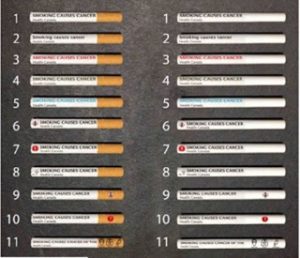Cynthia Callard, Physicians for a Smoke-Free Canada
The Canadian nicotine market was transformed virtually overnight after the government of Canada legalized the sale of vaping products in May 2018.
Previously, Canadians were able to buy unregulated vaping devices and liquids online or in a modest number of illegally-operating shopfronts. Their choice of device, however, was mostly limited to the clunky tank systems supplied by small manufacturers willing to sell on the grey market. Advertising for vaping products was seen only in the broadcasts and media that spilled over from the United States.
After market liberalization, Canadians could buy their (not yet) regulated devices and liquids in almost every corner store. Their choice of device was expanded to include the sleek and inexpensive systems sold by large multinational manufacturers, such as JUUL, BAT, Japan Tobacco, and Imperial Brands. Pod systems selling high concentrations of nicotine salts became the norm (JUUL boasts of a 79% market share). In many regions, advertising for vaping products has become pervasive: the cigarette power walls that were removed only a decade ago have now been replaced with vaping advertising.

A balancing act of competing policy objectives
These changes to the vaping market resulted from the government’s decision in 2017 to adopt a harm reduction approach to smoking. The new law was structured to “strike a balance between protecting youth from inducement to nicotine and tobacco use, while allowing adult smokers to legally access vaping products as a less harmful alternative to tobacco.”
With this decision, and the adoption of the Tobacco and Vaping Products Act, Canadians were abruptly enrolled in a natural experiment on the impact of a liberalized nicotine market on their health behaviours. Canadians have mixed views towards novel tobacco control measures, but many had supported greatly expanding access to vaping products.
Assessing the results of this experiment has been challenged by the absence of early data on the impact on nicotine use. The health surveillance systems in place for the first 18 months did not include any indicators on vaping: Canadian Tobacco, Alcohol and Drugs Survey had been suspended in 2017 and its replacement will not be in the field until November 2019.
Assessing the impact
To address the information gap, Health Canada issued contracts totalling more than USD 1 million to polling firms and other consumer researchers, tasking them with surveying Canadians about vaping. These studies, listed below, probed for information on a wide range of behaviours and attitudes related to nicotine use – why people start, which products they use, what they think of the harms, the flavours they use, whether their friends and families approve, etc.
These studies do not allow us to conclude whether the Canadian vaping experiment has resulted in a net reduction of harm from nicotine use. They do, however, give insight into the minds and motivations of users. When the surveillance system gets up and running, this consumer research can help guide policy adjustments if it appears that the harm reduction balance needs recalibrating.
Had these studies been conducted by University-based researchers, the results would normally find their way into the academic press. Canadian governments do not take this approach, but instead make the findings and data tables available through the federal government’s library of public opinion research. A trove of data ready for secondary analysis? (See links to research at the end of this article)
Research on traditional products too

Health Canada’s consumer research also covers traditional tobacco products. In preparation for updating tobacco package warning labels, consumer research was commissioned to test concepts and visuals. One of the studies looked at reactions to warnings printed directly on cigarettes – – an idea Health Canada floated last year.
Recent Health Canada consumer research:
On vaping
POR 037-18: Vaping Prevention Concepts Testing
16 in-person focus groups with 13 to 18 year olds to assess response to creative concepts for youth prevention campaigns.
POR: 099-17: Evaluation of Possible Labelling Elements for Vaping Products – Phase I and Phase II
12 in-person focus groups with adults (18+) to develop and assess response to labelling requirements.
POR 088-16: Qualitative/Quantitative Research on E-cigarette Flavours and Risk Perception
12 in-person focus groups and an on-line survey of 1509 Canadians who were between 15 and 24 years old.
POR 047-17: Longitudinal Vaper Panel Survey to Measure Attitudes and Behaviours regarding Vaping Products
Two waves of on-line surveys with vapers 15 years of age or older. Wave 1 surveyed 1312 ever vapers and Wave 2 reached 1,700+ vapers to allow for both longitudinal and cross- sectional analysis.
POR 083-18. Vapers Panel Survey to Measure Attitudes and Behaviours Regarding Vaping Products
On-line survey of 2,027 regular vapers (15 years of age or older).
POR 067-18: Qualitative and quantitative research on perceptions of nicotine
15 focus groups with Canadians aged 16 to 55, and an on-line survey of 4,190 Canadians aged 13 and older. Oversamples of youth and smokers were obtained.
POR 093-18: Smokers and Recent Quitters’ Awareness and Perceptions of Options to Minimize Harms from Nicotine and Tobacco Products
An on-line survey of 3,006 adult (18+) smokers and former smokers.
POR 014-18: Testing of Relative Risk Statements for Vaping Products
16 in-person focus groups with Canadians aged 15 to 24.
On smoking and tobacco products
POR 126-18: Qualitative Testing of Revised Health Warnings for Cigarette Packages and on Cigarette
40 in-person focus groups with Canadians aged 15 and older.
POR 119-18: Smoking Behaviour Journey Map
An innovative on-line survey of 500 smokers of whom 80 submitted daily journals.
POR 058-18: Public Opinion Research on Noticeability of Health Information Messages and effectiveness of Health Warnings for Tobacco Labelling
On-line survey of 3000 Canadian smokers (aged 16 years or older).